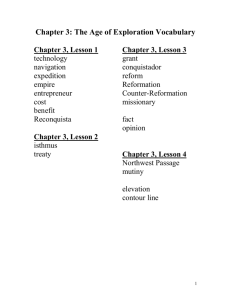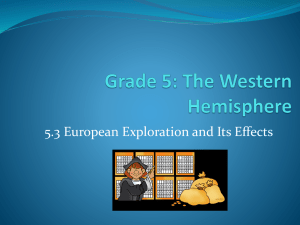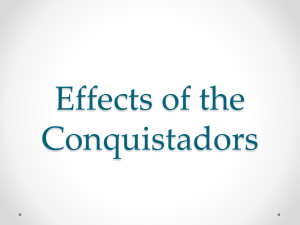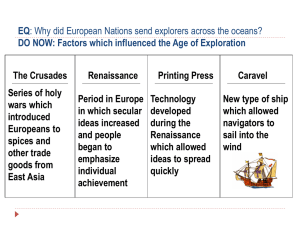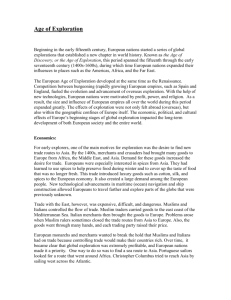Age of Exploration
advertisement
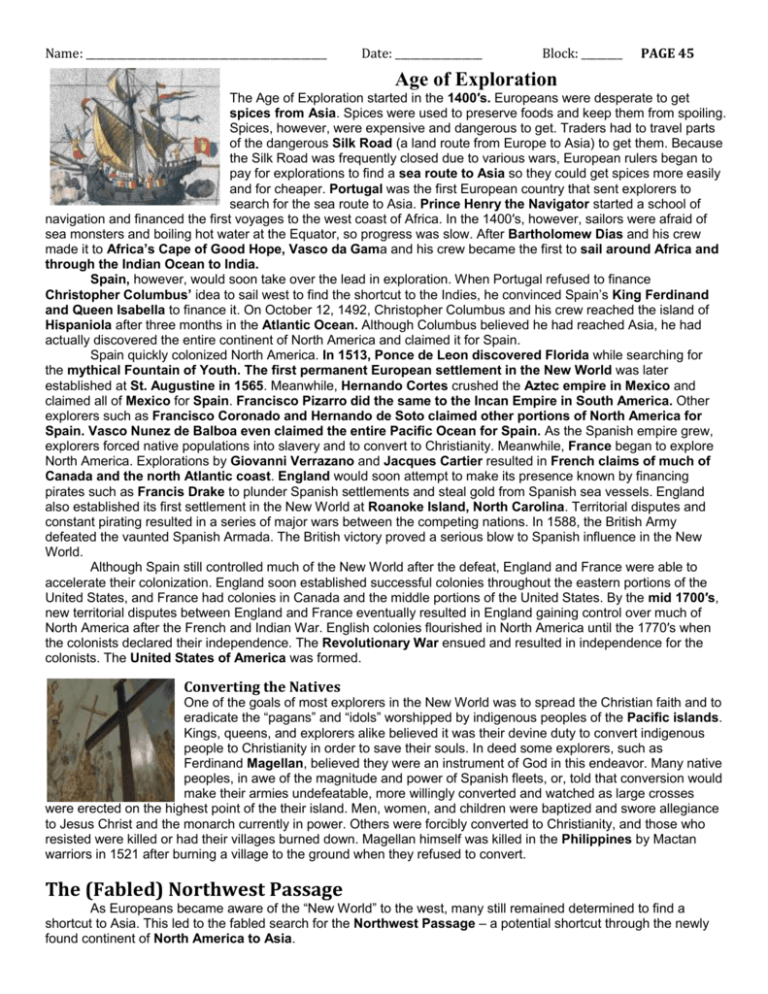
Name: _______________________________________________ Date: _________________ Block: ________ PAGE 45 Age of Exploration The Age of Exploration started in the 1400′s. Europeans were desperate to get spices from Asia. Spices were used to preserve foods and keep them from spoiling. Spices, however, were expensive and dangerous to get. Traders had to travel parts of the dangerous Silk Road (a land route from Europe to Asia) to get them. Because the Silk Road was frequently closed due to various wars, European rulers began to pay for explorations to find a sea route to Asia so they could get spices more easily and for cheaper. Portugal was the first European country that sent explorers to search for the sea route to Asia. Prince Henry the Navigator started a school of navigation and financed the first voyages to the west coast of Africa. In the 1400′s, however, sailors were afraid of sea monsters and boiling hot water at the Equator, so progress was slow. After Bartholomew Dias and his crew made it to Africa’s Cape of Good Hope, Vasco da Gama and his crew became the first to sail around Africa and through the Indian Ocean to India. Spain, however, would soon take over the lead in exploration. When Portugal refused to finance Christopher Columbus’ idea to sail west to find the shortcut to the Indies, he convinced Spain’s King Ferdinand and Queen Isabella to finance it. On October 12, 1492, Christopher Columbus and his crew reached the island of Hispaniola after three months in the Atlantic Ocean. Although Columbus believed he had reached Asia, he had actually discovered the entire continent of North America and claimed it for Spain. Spain quickly colonized North America. In 1513, Ponce de Leon discovered Florida while searching for the mythical Fountain of Youth. The first permanent European settlement in the New World was later established at St. Augustine in 1565. Meanwhile, Hernando Cortes crushed the Aztec empire in Mexico and claimed all of Mexico for Spain. Francisco Pizarro did the same to the Incan Empire in South America. Other explorers such as Francisco Coronado and Hernando de Soto claimed other portions of North America for Spain. Vasco Nunez de Balboa even claimed the entire Pacific Ocean for Spain. As the Spanish empire grew, explorers forced native populations into slavery and to convert to Christianity. Meanwhile, France began to explore North America. Explorations by Giovanni Verrazano and Jacques Cartier resulted in French claims of much of Canada and the north Atlantic coast. England would soon attempt to make its presence known by financing pirates such as Francis Drake to plunder Spanish settlements and steal gold from Spanish sea vessels. England also established its first settlement in the New World at Roanoke Island, North Carolina. Territorial disputes and constant pirating resulted in a series of major wars between the competing nations. In 1588, the British Army defeated the vaunted Spanish Armada. The British victory proved a serious blow to Spanish influence in the New World. Although Spain still controlled much of the New World after the defeat, England and France were able to accelerate their colonization. England soon established successful colonies throughout the eastern portions of the United States, and France had colonies in Canada and the middle portions of the United States. By the mid 1700′s, new territorial disputes between England and France eventually resulted in England gaining control over much of North America after the French and Indian War. English colonies flourished in North America until the 1770′s when the colonists declared their independence. The Revolutionary War ensued and resulted in independence for the colonists. The United States of America was formed. Converting the Natives One of the goals of most explorers in the New World was to spread the Christian faith and to eradicate the “pagans” and “idols” worshipped by indigenous peoples of the Pacific islands. Kings, queens, and explorers alike believed it was their devine duty to convert indigenous people to Christianity in order to save their souls. In deed some explorers, such as Ferdinand Magellan, believed they were an instrument of God in this endeavor. Many native peoples, in awe of the magnitude and power of Spanish fleets, or, told that conversion would make their armies undefeatable, more willingly converted and watched as large crosses were erected on the highest point of the their island. Men, women, and children were baptized and swore allegiance to Jesus Christ and the monarch currently in power. Others were forcibly converted to Christianity, and those who resisted were killed or had their villages burned down. Magellan himself was killed in the Philippines by Mactan warriors in 1521 after burning a village to the ground when they refused to convert. The (Fabled) Northwest Passage As Europeans became aware of the “New World” to the west, many still remained determined to find a shortcut to Asia. This led to the fabled search for the Northwest Passage – a potential shortcut through the newly found continent of North America to Asia. With new ship technology that enabled better navigation, searches for the Northwest Passage dominated exploration in the 1500′s and 1600′s. Voyages led by French explorers Jacques Cartier and Giovanni da Verrazano proved that there was not a water passage through the new continent. English explorers such as Henry Hudson and William Baffin searched for the Northwest Passage by trying to sail north of North America, but were met by forbidding arctic climate, snowstorms and icebergs. Indeed, North America’s northern tier was no shortcut to Asia, though a Northwest Passage to Asia through North America of some sort does exist. In 1969, the U.S.S. Manhattan, an iceberg-breaking ship, was the first ever to reach Asia by traveling the Northwest Passage. Today, global warming has made the Northwest Passage an ice-free possibility. Today, ownership of the future Northwest Passage has been the subject of international territory disputes. Pirates Sailing in the 1500′s was risky business. Not only were storms and disease real threats to the success of the voyage, but pirates were too! Pirates were roving bands of sea-mercenaries who attacked and plundered coastal villages and sea vessels. Pirates would sail throughout the sea, but were most numerous on the fabled “Barbary Coast”, where Islamic pirates attacked and stole from English ships along the north African coast. English and French pirates, in turn, frequently mobbed and destroyed Spanish shipping vessels in the Caribbean Sea. The most noted pirate, Sir Francis Drake, was so successful in stealing from the Spanish, in both the Caribbean and the western coast of South America, that the Queen of Spain demanded that Queen Elizabeth of England order him beheaded. Queen Elizabeth, instead, made him a knight. This was one of the reasons Spain declared war on England in 1588. Sea Monsters In the 1400′s and 1500′s, much of the world had not been explored. Large portions of the populations believed in myths and legends we would call ridiculous today. Many sailors aboard early seafaring vessels believed that terrible, serpent-like sea monsters existed, that the water boiled near the equator, and that a ship could simply sail off the edge of the world. Indeed, many of the maps published during these times came complete with sea monster images swimming in the oceans. Among the monsters reported by some expeditions was the Kraken, a large sea monster that could envelop ships and toss them into the air. Most reports were probably a combination of fact and exaggeration, as the Giant Squid and Basking Shark can appear as sea monsters to those not expecting them. There were even books published that detailed the various sea monsters that could be encountered in the open ocean. Among the monsters detailed was the aforementioned Kraken, and another that appeared as a lobster the size of a whale. Other monsters, known as “The Sea Bishop,” and “Sea Monk” had the heads of clergy men and the bodies of an unidentified sea creature. Guided Reading Questions PAGE 68 1. When was the Age of Exploration? __________________________________________________________ 2. What was the goal of the Age of Exploration? _________________________________________________ ________________________________________________________________________________________ 3. What was the (slower) land route? _________________ Road 4. Why did European rulers seek a sea route? ___________________________________________________ ________________________________________________________________________________________ 4. Name the explorer and his home country who was first to find the sea route to Asia. ________________________________________________________________________________________ 5. What hindered (slowed down) exploration? ___________________________________________________ 6. What did Dias and crew accomplish? ________________________________________________________ 7. What did Da Gama and crew accomplish? ____________________________________________________ 8. What country took the lead in 1492?_________________________________________________________ 9. Identify the conquistador who conquered the Aztecs. ___________________________________________ 10. Identify the conquistador who conquered the Inca. ____________________________________________ 11. Identify the conquistador who claimed the Pacific Ocean for Spain.________________________________ 12. Name two French explorers and identify the territories they claimed. ________________________________________________________________________________________ 13. For which European country did Sir Francis Drake perform acts of piracy/plunder? ________________________________________________________________________________________ 14. Who did he target?______________________________________________________________________ 15. Where was England’s first permanent settlement in the New World? ______________________________ 16. When did the competition for territory between England and France accelerate? ________________________________________________________________________________________ 17. What was the outcome? _________________________________________________________________ 18. Gold, God, and Glory were the three goals of explorers. Why were indigenous people encouraged to convert to Christianity? _____________________________________________________________________ 19. Describe the Northwest Passage (It was thought to lead from _______________ to ________________) and why explorers valued it._________________________________________________________________ 20. Identify three explorers who looked for the Northwest Passage. __________________________________ ________________________________________________________________________________________ 21. When did a ship finally make its way through the Northwest Passage? _____________________________ ________________________________________________________________________________________ 22. What did pirates do? ____________________________________________________________________ 23. Who was Sir Francis Drake, and what kind of royal ties did he have? ______________________________ ________________________________________________________________________________________ 24. What role did myths and legends of sea monsters play in sea explorations? ________________________ ________________________________________________________________________________________ 25. What are scientific explanations for these sea monsters? _______________________________________ ________________________________________________________________________________________
